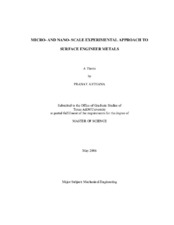| dc.description.abstract | This thesis includes two parts. The first part reviews the history and fundamentals of surface science and tribology. The second part presents the major research outcomes and contributions. This research explores the aspects of friction, wear, and surface modification for tribological augmentation of surfaces. An effort has been made to study these aspects through gaining insights by fundamental studies leading to specific practical applications in railroads. The basic idea was to surface engineer metals for enhanced surface properties. A micro- and nano- scale experimental approach has been used to achieve these objectives. Novel principles of nano technology are incorporated into the experiments. Friction has the potential to generate sufficient energy to cause surface reactions through high flash temperatures at the interface of two materials moving in relative motion. This allows surface modifications which can be tailored to be tribologically beneficial through a controlled process. The present work developed a novel methodology to generate a functional tribofilm that has combined properties of high hardness and high wear resistance. A novel methodology was implemented to distinguish sliding/rolling contact modes during experiments. Using this method, a super hard high-performance functional tribofilm with “regenerative†properties was formed. The main instrument used in this research for laboratory experiments is a tribometer, using which friction, wear and phase transformation characteristics of railroad tribo-pairs have been experimentally studied. A variety of material characterization techniques have been used to study these characteristics at both micro and nano scale. Various characterization tools used include profilometer, scanning electron microscope, transmission electron microscope, atomic force microscope, X-ray diffractometer, nanoindenter, and X-ray photon spectroscope. The regenerative tribofilms promise exciting applications in areas like gas turbines, automotive industry, compressors, and heavy industrial equipment. The outcome of this technology will be an economical and more productive utilization of resources, and a higher end performance. | en |


